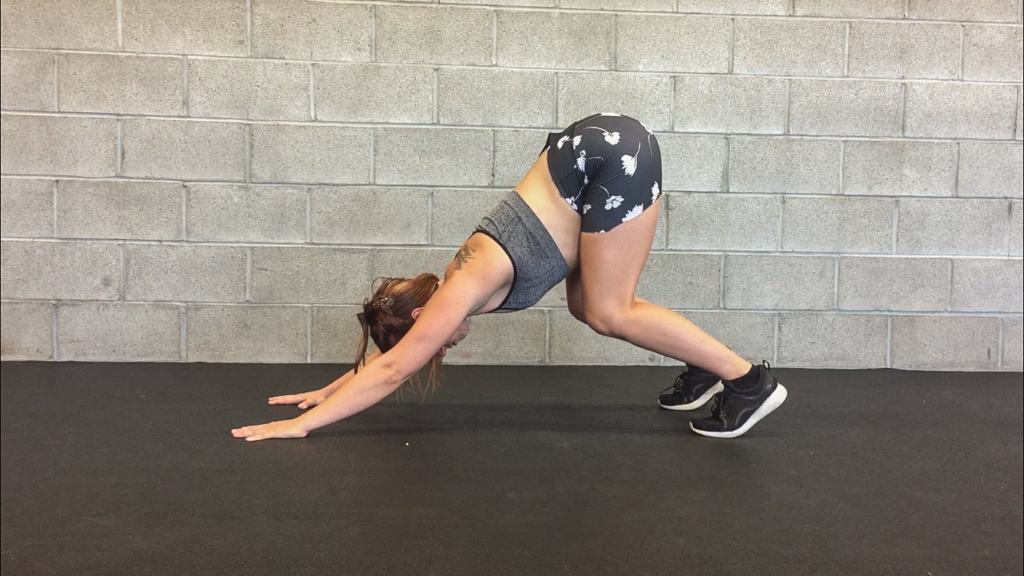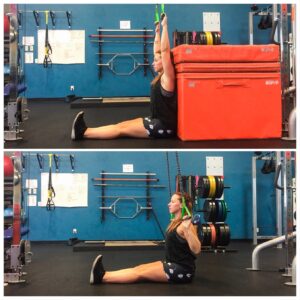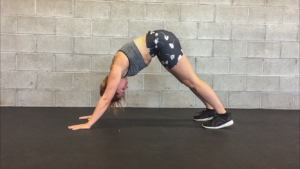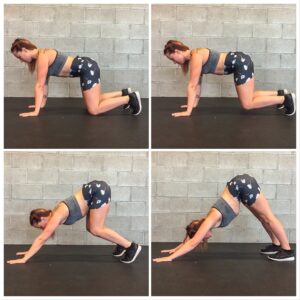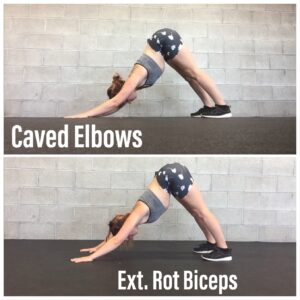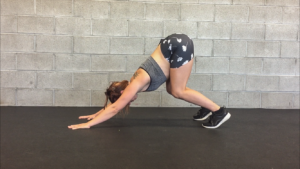With the continual advancement of technology and its prevalence in our day to day lives, health and fitness professionals are seeing an alarming increase in poor to downright detrimental posture among our clients. Long gone are the days where sitting up straight is not only the norm but expected; and with everyone looking down at phones or sitting at a computer all day, our postural muscles are paying for it. As a personal trainer you can improve your client’s exercise form, posture, and quality of life by simply adding a few exercises to each session which will help strengthen their postural muscles, such as the erector spinae.
Widespread Weak Posture
When I teach yoga the most common situation I encounter is the incredible discomfort and inability for my students to maintain sitting upright in a crossed leg position. Most yoga classes begin with a few moments of opening meditation or mindfulness. This is usually 5 to 10 minutes max of sitting still in a crossed leg or “Easy Seated Pose”. Even for intermediate to advanced students this can be the most challenging aspect of class, maintaining an upright and proper posture while seated. Some students are completely unable to sit up straight, even with a bolster under their hips. I’ve had many a student grumble to me at the end of class questioning why we “waste” so much time just sitting.
I understand their grumbly-ness and irritation. Anyone who has spent time practicing meditation or yoga knows the struggle and ache in the back as they try to maintain a correct posture. Some of the frustration is that they feel physically challenged to simply sit upright, and it seems like something one should just be able to do. However, with many people living a lifestyle that enables poor posture, the muscles that hold us up have no chance to gain or even maintain strength, and in fact, are getting weaker.
The muscles that are most responsible for maintaining our upright posture are the erector spinae. These comprise a muscle group that runs parallel to the spine from pelvis to the base of the skull. They break down into three muscles, the spinalis, the longissimus, and the illiocostalis.
The greatest modern opponent to posture is cell phones. One can check emails, bank accounts, social media, shop, read, play games, and dozens of other activities all from a phone; and society spends a lot of time doing so. With phones most often held in the hands this requires one to look down, which is where the issue lies. When looking to the screen it’s not just the head that falls forward but consequently the upper back as well.
With the head and upper back consistently in a rounded or flexed position, the erector spinae are perpetually overextended and weakened. This will cause the common sensation of tightness through the back and neck. Often this tightness is misconstrued for muscular tension rather than the weakness that it is. Individuals attempt to ease the sensation with stretching, when what is truly being called for is strengthening of these muscles.
Regardless of a client’s particular set of fitness goals, I always try to instill the importance of full-body mobility and strength to maintain overall physical health and the ability to perform everyday movements adequately. Not to say I don’t prioritize their desired goals, but most clients won’t recognize the mobility, and strength imbalances or understand how important it is to address them.
These are some of my go-to exercises that I use either in warm-ups or at the end of a session that help to promote strong erector spinae.
Unloaded Good Mornings
These are wonderful for teaching clients proper movement patterns involving a hip hinge, which is found in a multitude of different exercises, like squats, deadlifts, even bent-over rows. This exercise also calls on the erector spinae to maintain a static, neutral spine position while moving through different planes of motion.
Using a PVC pipe or wooden dowel, have the client hold the instrument behind them running along the spine. From here instruct them to maintain contact with the back of the skull, and the sacrum/tailbone region while they hinge forward at the hip and return to start.
This will not only teach them proper mechanics for hip hinge movements, it will also teach them the physical awareness of what it is to maintain a neutral spinal position and the muscle cues it requires. In addition, clients will learn how to pull the torso up using the muscles of the legs and glutes rather than compromising the low back.
I often use Good Mornings as a warm-up, either for sets of 15-20 reps or for time, 30-40 seconds.
L-Sit Overhead Press
This movement is wonderful for building strength in the back and the overall core musculature, and has a few progressions that can be applied as needed.
Beginner (no weight): Have the client sit with their back against a wall and their legs extended in front of them. As best as they can, have the entire length of the back making contact with the wall: Sacrum to tops of shoulders. In this position cue the client to mimic a Dumbbell Overhead Press. Even though they aren’t pressing true weight, instruct them to earnestly mimic that they are. Muscle force can still be generated without external weight, but more importantly, this position tests the available shoulder mobility with the lumbar spine prevented from excessive lordosis ( a common compensation).
It is important to have the client maintain a neutral spinal position while performing this exercise; ie: they aren’t excessively arching the lumbar region when the press up or rounding the thoracic spine when the hands come down. This exercise is great for helping a client understand pelvic tilt and how to use the abdominal muscles to maintain a neutral position.
Intermediate (add weight): Progress the above by adding dumbbells to the overhead press.
Advanced (loaded, unsupported): The last progression is moving this exercise away from the wall and performing it unsupported. Be sure to keep cueing the neutral spine!
L-sit Lat-Pull Down:
The set up for this exercise is the same as the overhead press, however the client is engaging the pull muscles of the back. You can see in the pictures how I have set this up. The progressions are very similar.
Beginner: Mimic pulling down as if pulling true weight, the same as they mimic pressing in the other variation. Cue the client to actively press the elbows and hands back towards the wall on the concentric contraction.
Intermediate: Add resistance; I usually apply a resistance band for this.
Advanced: Unsupported with either a resistance band or using a cable machine if such equipment is available.
Downward Dog
This yoga pose will help reveal where their client is at in regards to spinal strength, and also help improve it.
Those with weak erector spinae or a weak back body, in general, will be represented in the rounding of the upper back and/or excessive tucking of the tail bone, as I am demonstrating in the image.
Have the client start in tabletop position on hands and knees; from here cue them to enter down dog in this sequence of movements:
- Curl the toes under
- Lift the knees from the ground only about an inch or two
- Arms straight, press the chest towards the thighs, which will start to move the head between the arms
- Then pike the hips up, press the heels down, straighten the legs, and align the ears between the biceps.
Often individuals will try to move their hands closer or further away from the feet, usually because the pose will feel easier with whichever adjustment. However, those doing so is detracting from the purpose of this pose.
Instruct the client to maintain their hands and feet in the space they were within tabletop. The hands and feet do not move; the body moves its position. This is going to provide the correct body placement for this particular yoga pose. The client can modify by bending the knees and lifting the heels rather than moving the hands or feet.
Cue the client to actively press the heels towards the ground, regardless if they are touching or not, this will correctly engage the legs within this pose.
Often when executing this pose a beginner’s elbows will cave in towards the mid-line. Cue the client to externally rotate the upper arms, I always say, “Biceps turn away from the face.”
This is the aspect of the pose that provides strengthening to the upper back and the body awareness to maintain the neutral spine position.
I usually apply this as a warm-up. I have the client start in tabletop and on an exhale move into downward dog, where they hold the position for 3 breaths or 15 seconds, and then move back to tabletop. I consider this one rep, and have them perform 8-10 for 1-2 sets.
Practice Makes Perfect Posture
Overall practicing and employing correct posture will improve a client’s physical health: proper body alignment, strong and sustainable postural muscles, reduce neck and low back pain, improve breathing mechanisms (more space for the lungs to fully expand), and allow the digestive system to operate at its optimum level. Standing and sitting tall also subconsciously boosts one’s confidence and influences others to perceive us as confident. There’s a reason we always say “stand tall” when we’re about to do something that makes us nervous.
These exercises are just an introduction on approaches to target the erector spinae, but they are approachable movements great for the beginner client. Give them a try and explore these concepts. I bet you will come up with some effective exercises of your own, and your clients will be standing tall in no time.
